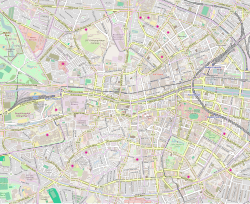Stoneybatter (Irish: Bóthar na gCloch), is a neighbourhood of Dublin, Ireland, on the Northside of the city between the River Liffey, the North Circular Road, Smithfield Market, and Grangegorman. It is in the D7 postal district.[1]
Stoneybatter
Bóthar na gCloch | |
|---|---|
Neighbourhood of Dublin | |
 Stoneybatter, Dublin | |
| Coordinates: 53°21′02″N 6°16′35″W / 53.35056°N 6.27639°W | |
| Country | Ireland |
| County | Dublin |
| City | Dublin |
| Postal district | D7 |
It is often referred to as Dublin's "hipster quarter",[2] and was in Time Out's list of coolest neighbourhoods in the world in 2019.[3]
History
editJames Collins' 1913 book Life in Old Dublin notes that "Centuries ago (Stoneybatter) was called Bothar-na-gCloch". In Joyce's Irish names of places we find the following interesting information as to the original name of the place: "Long before the city had extended so far, and while Stoneybatter was nothing more than a country road, it was -- as it continues to be -- the great thoroughfare to Dublin from the districts lying west and north-west of the city; and it was known by the name of Bothar-na-gCloch (Bohernaglogh), i.e. the road of the stones, which was changed to the English equivalent, Stoneybatter or stony road".
Stoneybatter is mentioned as the district from which the two sisters, the Misses Morkan, had moved to Usher's Island, in the exposition at the beginning of James Joyce's final story in Dubliners, "The Dead". Stoneybatter is also the main location for events in the Tana French novel "The Trespasser," and the area is mentioned in the Irish folk song "The Spanish Lady".
In recent years the area has become known as an example of an area undergoing gentrification.[4][5][6][7]
Local street names
editViking names
editApart from the striking artisan dwellings, the area is also known for its prominent Viking street names. For example, there is Viking Road, Olaf Road, Thor Place, Sitric Road, Norseman Place, Ard Ri Road, Malachi Road, Ostman Place, Ivar Street, Sigurd Road and Harold Road. At the time of the Norman invasion, the Vikings, Ostmen or Austmenn (men of the East) as they called themselves, were exiled to the north of the Liffey where they founded the hamlet of Ostmenstown, later to become Oxmantown.
Other street names
editThe northern end of Stoneybatter derives its name of Manor Street, bestowed in 1780, from the Manor of Grangegorman in which it was located. During the reign of Charles II (1660–1680), the Manor was held by Sir Thomas Stanley, a knight of Henry Cromwell and a staunch supporter of the Restoration. The short thoroughfare in Stoneybatter called Stanley Street is named after him.[8][9]
Transport
editStoneybatter is served by Dublin Bus routes 37, 39/a, 46a and 70, which connect the neighbourhood to the city centre, Phoenix Park, Cabra, Ashtown, Castleknock, Blanchardstown, Ongar, Clonee, Dunboyne, Donnybrook, Belfield, Stillorgan, Deansgrange and Dún Laoghaire. The Luas stops at Smithfield and Phibsborough are located nearby, but no Luas stop directly serves the neighbourhood of Stoneybatter. Heuston station is also close by, served by both InterCity and Commuter rail services.
Popular culture
editThis section needs additional citations for verification. (July 2015) |
The streets and surrounding areas of Stoneybatter have been used as a filming location for both TV and film. Notable productions, filmed in the area, include:
TV series
edit- Dear Sarah (1989)
- Who Do You Think You Are? (2014)
- Who Do You Think You Are? (Ireland) (2018)
- Modern Love (TV series) (2020)[10]
Film
edit- Robbery (1967)[11]
- Educating Rita (1983)
- Michael Collins (1996)
- The Informant (1997)
- The Boxer (1997)
- Angela's Ashes (1999)
- When Brendan Met Trudy (2000)[12]
- Shadow Dancer (2012)
- Love, Rosie (2014)
- Nan: The Movie (2020)
- The Miracle Club (2023)[13]
Music
edit- Spice Girls – "Stop" (1998)
See also
editReferences
edit- ^ M'Cready, C. T. (1987). Dublin Street Names: Dated and Explained. p. 128.
- ^ Freeman, Michael. "Your guide to Stoneybatter: Dublin's inner-city village with hipsters and a lot of heart". TheJournal.ie.
- ^ "The 40 coolest neighbourhoods in the world". Time Out Worldwide.
- ^ Freeman, Michael. "Your guide to Stoneybatter: Dublin's inner-city village with hipsters and a lot of heart". TheJournal.ie. Retrieved 28 July 2020.
- ^ "Dublin Voices: Stoneybattered!". Dublin.ie. Retrieved 28 July 2020.
- ^ Birdthistle, Elizabeth. "Hipster transformation in Stoneybatter for €490,000". The Irish Times. Retrieved 28 July 2020.
- ^ "Facing up to the Gentrification of Dublin". Random Public Journal. 14 April 2016. Retrieved 28 July 2020.
- ^ Cosgrave, Augustine Dillon, and Carm, O., 'North Dublin City' in Dublin Historical Record, 23(1) (June 1969), p.7.
- ^ Ball, Francis Elrington, A History of County Dublin, Volume 6 (Dublin, 1920).
- ^ Hutch, Eleanore. "EVOKE gets sneak peek at Modern Love season two, filming in Dublin". evoke.ie. Retrieved 12 November 2020.
- ^ "ReelStreets: Robbery". ReelStreets. Retrieved 12 November 2020.
- ^ MICHAEL DWYER (24 December 1999). "When Roddy met romance". The Irish Times. Archived from the original on 16 March 2019.
- ^ LionsgateFilmsUK (27 June 2023). The Miracle Club – Official Trailer – In Cinemas October 13. Retrieved 19 May 2024 – via YouTube. Church in trailer is Aughrim Street Church
